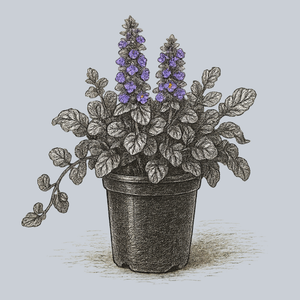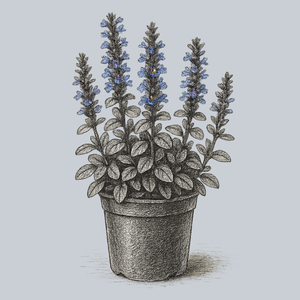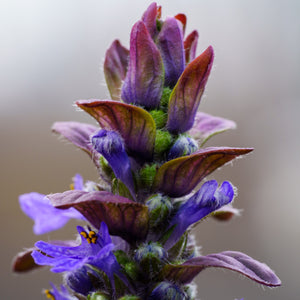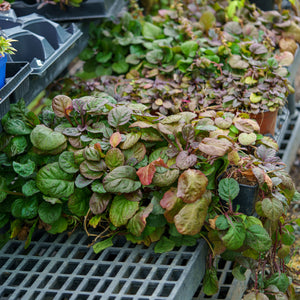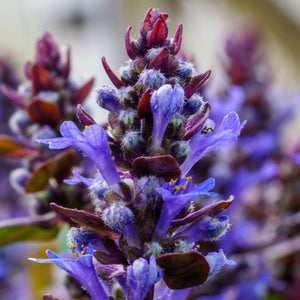The Ajuga Guide
Ajuga, commonly known as bugleweed, is a fast-growing, low-maintenance ground cover prized for its attractive foliage and vibrant flower spikes. A member of the mint family (Lamiaceae), Ajuga spreads quickly to form dense mats of colorful leaves that suppress weeds and add year-round interest to the landscape. With cultivars featuring deep purples, bronzes, greens, and variegated patterns, Ajuga is an excellent choice for shady garden beds, pathways, and erosion control. Here’s everything you need to know about growing and caring for Ajuga.
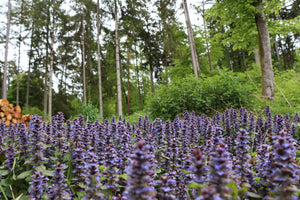
About
Ajuga is a genus of herbaceous perennials native to Europe, Asia, and North Africa. The most widely cultivated species, Ajuga reptans, is a spreading evergreen ground cover that thrives in various soil conditions and light levels. The foliage can range from deep purple and bronze to variegated green, pink, and cream, making Ajuga a versatile addition to any garden design.
During spring and early summer, Ajuga produces short spikes of small, tubular flowers in shades of blue, purple, pink, or white, which attract bees, butterflies, and other pollinators. Popular cultivars include Ajuga reptans 'Black Scallop', known for its glossy, near-black foliage; Ajuga reptans 'Burgundy Glow', featuring stunning tri-color leaves; and Ajuga reptans 'Chocolate Chip', a compact variety with narrow leaves and blue flowers.
Ajuga is highly adaptable and can be grown in full sun to partial shade, though it prefers moist, well-draining soil. Due to its spreading nature, it is often used for erosion control on slopes and as a weed-suppressing ground cover. While it spreads aggressively in ideal conditions, it is easy to manage with periodic thinning. Whether used as a focal point in a woodland garden or as a lush carpet beneath trees and shrubs, Ajuga adds texture and color to any space.
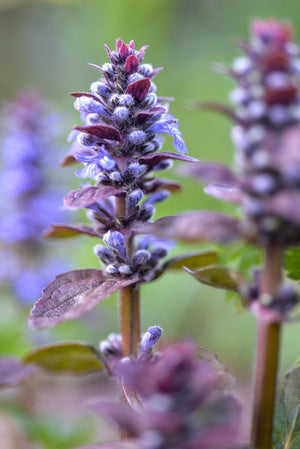
PLANTING
- USDA Hardiness Zones: Most Ajuga varieties thrive in Zones 3-9, making them suitable for a wide range of climates.
- Soil: Prefers moist, well-draining soil with moderate fertility. Ajuga tolerates clay and sandy soils but performs best with organic matter added.
- Sunlight: Grows well in full sun to partial shade. In hotter climates, partial shade helps prevent leaf scorch, while in cooler regions, full sun promotes vibrant foliage.
- Watering: Water regularly during the first growing season to help plants establish deep roots. Once established, Ajuga is moderately drought-tolerant but benefits from occasional watering during dry periods.
- Spacing: Space plants 8-12 inches apart, as they spread quickly to fill in gaps.
- Planting Time: Best planted in early spring or fall when temperatures are mild and soil moisture levels are stable.
To plant Ajuga, loosen the soil and mix in compost for added nutrients. Dig a hole slightly larger than the root ball, place the plant, and backfill with soil. Water thoroughly after planting to encourage root establishment.
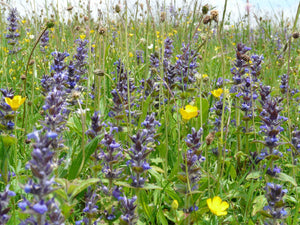
CARE
- Watering: Established Ajuga plants require minimal watering, though they appreciate occasional moisture during prolonged dry spells.
- Pruning: Trim back flower spikes after blooming to maintain a tidy appearance. Thin out crowded areas in early spring to improve airflow and prevent fungal issues.
- Fertilizing: Apply a light layer of compost or balanced fertilizer in early spring to encourage healthy growth. Avoid excessive fertilization, which can lead to overly aggressive spreading.
- Pests & Diseases: Ajuga is generally pest-resistant but can be susceptible to crown rot in overly wet conditions. Ensuring proper drainage and thinning dense plantings can help prevent fungal issues.
- Dividing: Every 2-3 years, divide large clumps to control spread and rejuvenate older plants. This is best done in early spring or fall.
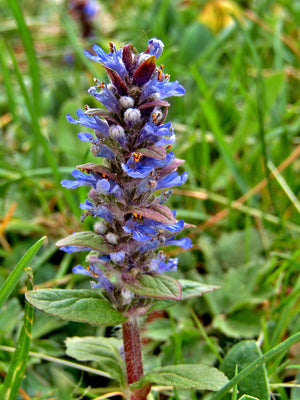
HOW TO USE
Ajuga’s versatility makes it a valuable addition to various garden settings:
- Ground Cover: Ideal for filling gaps between stepping stones, covering bare soil under trees, or adding texture to shady garden beds.
- Erosion Control: Its dense, spreading habit helps stabilize slopes and prevent soil erosion.
- Pollinator Gardens: Ajuga’s nectar-rich flowers attract bees, butterflies, and other beneficial insects in early summer.
- Container Gardening: Compact varieties like Ajuga reptans 'Chocolate Chip' thrive in pots and hanging baskets, where they spill over edges beautifully.
- Companion Planting: Pairs well with hostas, ferns, coral bells (Heuchera), and ornamental grasses to create stunning foliage contrasts.
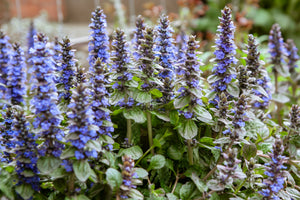
Common Questions
- Is Ajuga invasive? While Ajuga spreads rapidly, it is not classified as invasive in most regions. However, in ideal conditions, it may require occasional thinning to prevent overgrowth.
- Does Ajuga die back in the winter? In colder climates, Ajuga may experience some dieback, but most varieties remain evergreen or semi-evergreen year-round.
- Is Ajuga poisonous to dogs? No, Ajuga is considered non-toxic to dogs and safe for pet-friendly gardens.
- Is Ajuga poisonous to cats? No, Ajuga is non-toxic to cats, making it a great choice for households with pets.
- Do deer eat Ajuga? Ajuga is generally deer-resistant due to its aromatic foliage, though hungry deer may sample young plants.
- Is Ajuga evergreen? Yes, Ajuga is an evergreen or semi-evergreen ground cover in most climates, providing year-round interest.
- What to plant with Ajuga? Ajuga pairs well with shade-loving perennials like hostas, ferns, astilbe, and hellebores, as well as contrasting textures from ornamental grasses and sedges.
Conclusion
Ajuga is a resilient, low-maintenance ground cover that brings texture, color, and ecological benefits to the garden. Whether used for erosion control, as a weed-suppressing carpet, or to enhance the beauty of shade gardens, its striking foliage and vibrant blooms make it a standout choice. With cultivars like Ajuga reptans 'Black Scallop', Ajuga reptans 'Burgundy Glow', and Ajuga reptans 'Chocolate Chip', there's an Ajuga variety to complement any garden design. Explore our selection and enjoy the beauty and versatility of bugleweed in your landscape.
The Ajuga Collection
Sold Out

